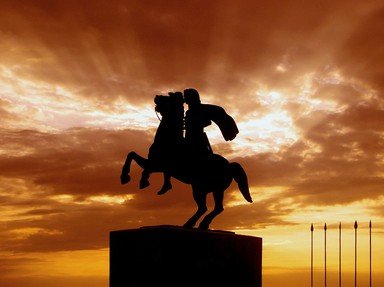Quiz Answer Key and Fun Facts
1. The failures of Constantine XI Palaiologos can be seen in his lack of proper war preparations. With the formidable forces of the Ottomans knocking at his door, he lacked the diplomatic acumen to rally his Christian allies to his defense. He also failed to stockpile supplies and prepare adequately for a siege, leading to the Fall of Constantinople in 1453. Which empire came to doom due to his errors?
2. Great-grandson to Charlemagne, Charles the Fat oversaw the fall of an immense empire that had been previously divided by his father and uncles. Often seen as spineless and paranoid, his death led to what empire being fractured beyond recognition?
3. Emperor Xian had numerous failures as a leader. He was unable to assert control over the eunuchs of the court, who had dominated its power structures. He also failed to manage widespread corruption and unrest, leading to the Yellow Turban Rebellion. Which long-lasting dynasty came to an end under his rule?
4. Known as the Felon King, the chaotic rule of Ferdinand VII saw an abdication, a restoration, a revolt, a civil war upon his death, and the general dissolution of which kingdom's colonial empire?
5. Bahadur Shah Zafar, a poet, was little more than a figurehead in his vastly-diminished empire. Nonetheless, once the British found him to be of no more use, he was deposed. Which empire saw its last ruler removed from power in 1857?
6. Aethelred the Unready could certainly be said to have lived up to his royal epithet. His failure to repel the Vikings, his murder of the Danes during the St. Brice's Day massacre, and his subsequent military defeat led the Danes to take control of which kingdom in 1016?
7. Otto, second son of King Ludwig I of Bavaria, ruled ineffectively as an absolute monarch of what country until he was deposed in 1862, leading his successor, George I, to establish a constitutional monarchy as King of the Hellenes?
8. Sometimes referred to as Toom Tabard (meaning "empty coat"), John Balliol was far too subservient to the English king for his own people's liking. In an effort to appear strong, he made an alliance with France, which ultimately led to his downfall. Which country was he king of for only four years?
9. Marwan II ruled over a vast, diverse caliphate that stretched from present-day Spain to parts of India. However, he wasn't able to mend the caliphate's cultural differences, not to mention his failure to stem the power of the Abbasids. Which of these was he the last caliph of? (Pictured are his gold dinar, since images of the caliphs were often forbidden.)
10. Maximilian I was a European who was far from home. Installed by the French, he tried to rule his empire with the help of the French military, who were largely on their way out. He failed miserably at making any political group happy, ending with his execution. Which empire did he rule?
Source: Author
trident
This quiz was reviewed by FunTrivia editor
gtho4 before going online.
Any errors found in FunTrivia content are routinely corrected through our feedback system.
